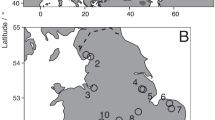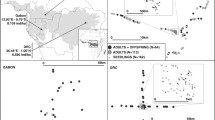Abstract
Because wind pollination is inefficient over longer distances, plants dependent on it may suffer Allee effects (lower individual reproductive fitness with lower density). However, at higher density, individual reproductive fitness may suffer because of intraspecific competition. We investigate density-dependent effects, via stand size, on cone and seed production and seed germinability in a conifer endemic to tropical Australia. Callitris intratropica R.T. Baker & H.G. Smith is an obligate-seeding tree that often occurs in monodominant stands embedded within savannas and on the fringes of monsoon forests. We found that isolated trees (50–300 m from stands) were taller, of broader profile, and produced approximately twice the number of cones (~407 cones per tree) as those in large stands (~173 cones per tree), suggesting that monodominance generates intraspecific competition. The number of seeds per cone (27 seeds) was not related to stand size. However, a contrasting effect in which seed germinability was higher in large stands (~20 vs. <10 % in small stands) was approximately compensatory and consistent with an Allee effect of wind pollination. The net effect of an approximately even trade-off between cone production and seed germinability was that there was neither an Allee or density-dependent effect of stand size on fitness, measured as the number of germinable seeds per tree. Nevertheless, because the likelihood of cross-fertilisation declines with distance, the ability of C. intratropica to persist as very isolated individuals may be limited.

Similar content being viewed by others
References
Allee WC (1931) Animal aggregations. A study in general socioecology. University of Chicago Press, Chicago
Bowman DMJS, Harris S (1995) Conifers of Australia’s dry forests and open woodlands. In: Enright NJ, Hill RS (eds) Ecology of the southern conifers. Melbourne University Press, Carlton, pp 252–270
Bowman DMJS, Panton WJ (1993) Decline of Callitris intratropica R.T. Baker & H.G. Smith in the Northern Territory: implications for pre- and post-European colonization fire regimes. J Biogeogr 20:373–381
Bowman DMJS, Wilson BA (1988) Fuel characteristics of coastal monsoon forests, Northern Territory, Australia. J Biogeogr 15:807–817
Bowman DMJS, Wilson BA, Davis GW (1988) Response of Callitris intratropica R.T. Baker & H.G. Smith to fire protection, MurgenelIa, Northern Australia. Aust J Ecol 13:147–159
Bowman DMJS, Prior LD, Tng DYP, Hua Q, Brodribb TJ (2011) Continental-scale climatic drivers of growth ring variability in an Australian conifer. Trees 25:925–934. doi:10.1007/s00468-011-0567-5
Brodribb TJ, Bowman DJMS, Nichols S, Delzon S, Burlett R (2010) Xylem function and growth rate interact to determine recovery rates after exposure to extreme water deficit. New Phytol 188:533–542. doi:10.1111/j.1469-8137.2010.03393.x
Brook BW, Bradshaw CJA (2006) Strength of evidence for density dependence in abundance time series of 1198 species. Ecology 87:1445–1451
Cohn JS, Lunt ID, Ross KA, Bradstock RA (2011) How do slow-growing, fire-sensitive conifers survive in flammable eucalypt woodlands? J Veg Sci 22:425–435. doi:10.1111/j.1654-1103.2011.01280.x
Davis HG, Taylor CM, Lambrinos JG, Strong DR (2004) Pollen limitation causes an Allee effect in a wind-pollinated invasive grass (Spartina alterniflora). Proc Natl Acad Sci USA 101:13804–13807. doi:10.1073/pnas.0405230101
Feldman TS, Morris WF (2011) Higher survival at low density counteracts lower fecundity to obviate Allee effects in a perennial plant. J Ecol 99:1162–1170. doi:10.1111/j.1365-2745.2011.01855.x
Friedman J, Barrett SCH (2009) Wind of change: new insights on the ecology and evolution of pollination and mating in wind-pollinated plants. Ann Bot 103:1515–1527
Ghazoul J (2005) Pollen and seed dispersal among dispersed plants. Biol Rev 80:413–443
Ghazoul J, Satake A (2009) Nonviable seed set enhances plant fitness: the sacrificial sibling hypothesis. Ecology 90:369–377. doi:10.1890/07-1436.1 %U http://www.esajournals.org/doi/abs/10.1890/07-1436.1
Hammer GL (1981) Site classification and tree diameter-height-age relationships for cypress pine in the top end of the Northern Territory. Aust For 44:35–41
Hesse E, Pannell JR (2011) Density-dependent pollen limitation and reproductive assurance in a wind-pollinated herb with contrasting sexual systems. J Ecol 99:1531–1539. doi:10.1111/j.1365-2745.2011.01880.x
Hill KD (1998) Callitris http://www.environment.gov.au/biodiversity/abrs/online-resources/flora/main/index.html Accessed 31st March 2012
Lamont BB, Klinkhamer PGL, Witkowski ETF (1993) Population fragmentation may reduce fertility to zero in Banksia goodii—a demonstration of the Allee effect. 94:446–450
Lunt ID, Zimmer HC, Cheal DC (2011) The tortoise and the hare? Post-fire regeneration in mixed Eucalyptus–Callitris forest. 59:575–581. doi:http://dx.doi.org/10.1071/BT11151
Peh KS-H, Lewis SL, Lloyd J (2011) Mechanisms of monodominance in diverse tropical tree-dominated systems. J Ecol 99:891–898
Prior LD, McCaw WL, Grierson PF, Murphy BP, Bowman DMJS (2011) Population structures of the widespread Australian conifer Callitris columellaris are a bio-indicator of continental environmental change. For Ecol Manag 262:252–262. doi:10.1016/j.foreco.2011.03.030
Restoux G, Silva DE, Sagnard F, Torre F, Klein E, Fady B (2008) Life at the margin: the mating system of Mediterranean conifers. Web Ecol 8:94–102
Russell-Smith J (2006) Recruitment dynamics of the long-lived obligate seeders Callitris intratropica (Cupressaceae) and Petraeomyrtus punicea (Myrtaceae). Aust J Bot 54:479–485
Russell-Smith J, Edwards AC, Price OF (2012) Simplifying the savanna: the trajectory of fire-sensitive vegetation mosaics in northern Australia. J Biogeogr 39:1303–1317. doi:10.1111/j.1365-2699.2012.02679.x
Sharp BR, Bowman D (2004) Patterns of long-term woody vegetation change in a sandstone-plateau savanna woodland, Northern Territory, Australia. J Trop Ecol 20:259–270
Stephens PA, Sutherland WJ (1999) Consequences of the Allee effect for behaviour, ecology and conservation. TREE 14:401–405
Stocker GC (1966) Aspects of the seeding habits of Callitris intratropica. Forestry and Timber Bureau Leaflet No. 97. Department of National Development, Canberra
Sutherland WJ (1996) Ecological census techniques: a handbook. Cambridge University Press, Cambridge
Trauernicht C, Murphy BP, Portner TE, Bowman DMJS (2012) Tree cover–fire interactions promote the persistence of a fire-sensitive conifer in a highly flammable savanna. J Ecol 100:958–968. doi:10.1111/j.1365-2745.2012.01970.x
Williams CG (2009) Conifer reproductive biology. Springer, New York. doi:10.1007/978-1-4020-9602-0
Williams CG, Auckland LD, Reynolds MM, Leach KA (2003) Overdominant lethals as part of the conifer embryo lethal system. Heredity 91:584–592
Acknowledgments
This research was conducted under permit number 33360 (NRETAS: Permit to undertake scientific research on wildlife). We are grateful to the staff of Litchfield National Park for their assistance and support.
Author information
Authors and Affiliations
Corresponding author
Rights and permissions
About this article
Cite this article
Lawes, M.J., Taplin, P., Bellairs, S.M. et al. A trade-off in stand size effects in the reproductive biology of a declining tropical conifer Callitris intratropica . Plant Ecol 214, 169–174 (2013). https://doi.org/10.1007/s11258-012-0155-9
Received:
Accepted:
Published:
Issue Date:
DOI: https://doi.org/10.1007/s11258-012-0155-9




